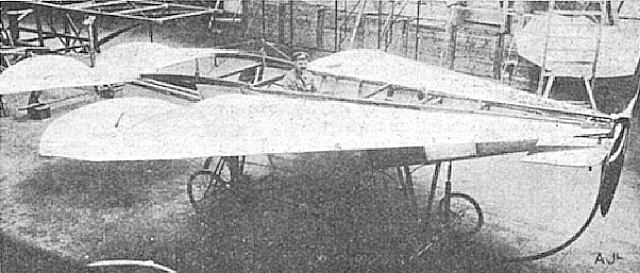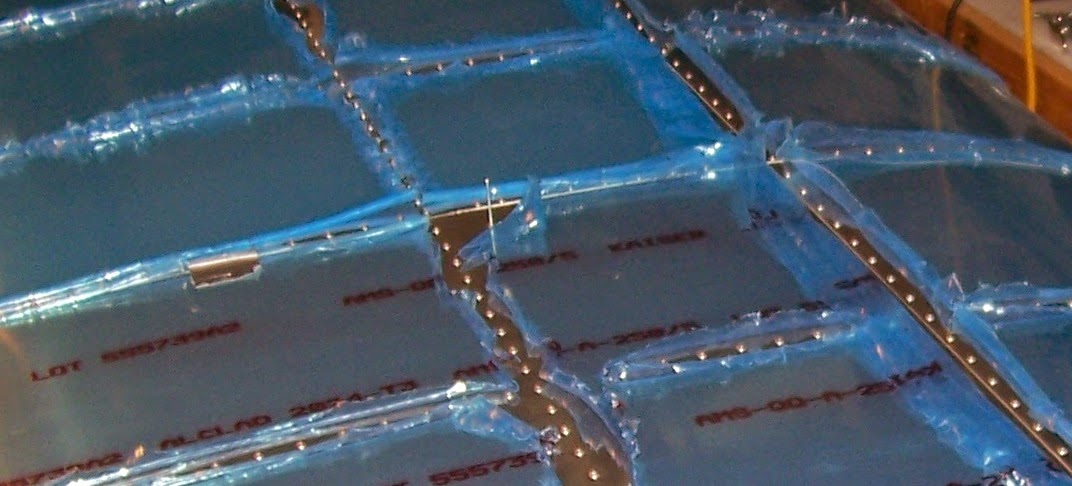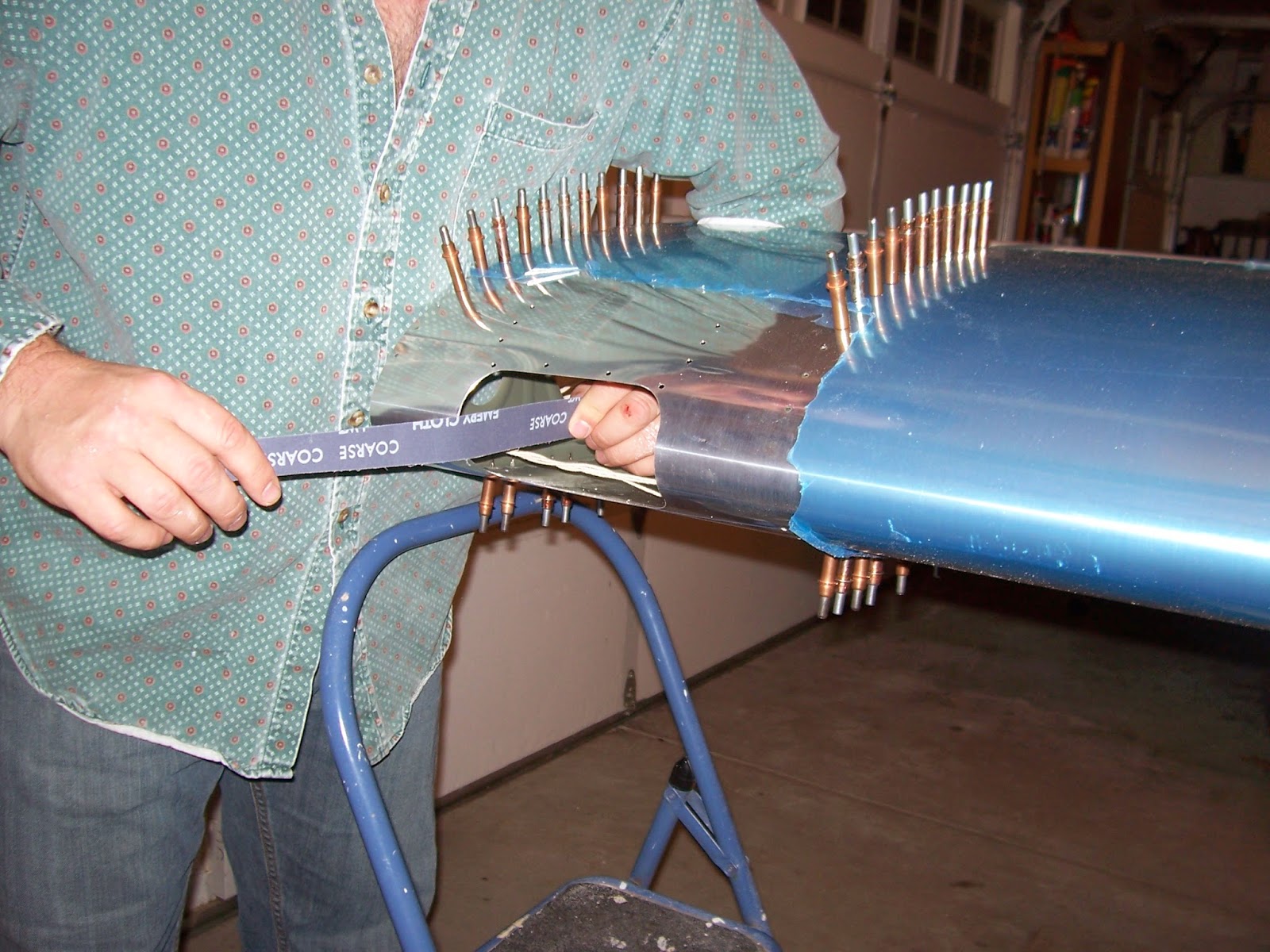 Now that the right wing is done (except for the nav-strobe light and fairing that goes on the wing tip), it was time to hang it out of the way. In my opinion a wide strap near the outboard end is the way to go. Luckily for my wallet an RV builder in Davis gave me about 50 feet of fire hose that he no longer needed that fit the need perfectly. Are airplane builders the nicest people or what? As an indoor-use hose the outer canvas cladding is surprisingly silky, so I don't have to worry about it scratching the aluminum wing skins. But first I had to find something that could poke through four layers of lined canvas to sew on D-rings that I bought through berkeleypoint.com
Now that the right wing is done (except for the nav-strobe light and fairing that goes on the wing tip), it was time to hang it out of the way. In my opinion a wide strap near the outboard end is the way to go. Luckily for my wallet an RV builder in Davis gave me about 50 feet of fire hose that he no longer needed that fit the need perfectly. Are airplane builders the nicest people or what? As an indoor-use hose the outer canvas cladding is surprisingly silky, so I don't have to worry about it scratching the aluminum wing skins. But first I had to find something that could poke through four layers of lined canvas to sew on D-rings that I bought through berkeleypoint.comAfter searching the internet I found what I needed: The Speedy Stitch Sewing Awl. According to speedystitcher.com,
"The Speedy Stitcher Sewing Awl is a hand tool that can be used to sew any heavy material. It's a handy tool to have around the house, farm, workshop or any place where leather, canvas or vinyl has to be sewn or repaired.
Every Speedy Stitcher is Made in the USA and comes with our high-tensile waxed thread and custom-made diamond point needles. With a little practice, it sews a perfect lock stitch every time - just like a sewing machine.
Uses for the Speedy Stitcher include the assembly and repair of leather goods, canvas tarps, climbing and camping gear, saddlery and tack items, athletic equipment, even shoes and belts."
 So I ordered one from Amazon for $12. A week later I found the same thing at Harbor Freight (or Chinese knock-off, probably) for $8 that included a big bobbin of canvas thread. Grrr.
So I ordered one from Amazon for $12. A week later I found the same thing at Harbor Freight (or Chinese knock-off, probably) for $8 that included a big bobbin of canvas thread. Grrr.Know what else I found at Harbor Freight Sewing and Toiletries Supply Store while shopping for removable chain links? A cheap ear and nose hair trimmer. Score! I've been needing one of those for a while now. Sorry, is that TMI?
 After watching a couple YouTube videos on how to use the durn thing, I went to work. With three rows of lock-stitching and high-strength thread I feel pretty good about the sewing job I did. You could probably tow a car with it. Heck, you could probably lift a car with it. The wing that this thing will be holding up weighs less than a hundred pounds. I figure the weakest link is the four-inch lag bolts screwed into the ceiling joists. I'm not sure how you would estimate the strength on those, but I'm comfortable knowing that there are six lag bolts being deployed for each wing.
After watching a couple YouTube videos on how to use the durn thing, I went to work. With three rows of lock-stitching and high-strength thread I feel pretty good about the sewing job I did. You could probably tow a car with it. Heck, you could probably lift a car with it. The wing that this thing will be holding up weighs less than a hundred pounds. I figure the weakest link is the four-inch lag bolts screwed into the ceiling joists. I'm not sure how you would estimate the strength on those, but I'm comfortable knowing that there are six lag bolts being deployed for each wing.
A few rows of stitches and the first D-ring was securely sewn on.
Once I double-checked the length needed I cut the hose, sewed a D-ring on the other end, and added a third D-ring in between. Having three D-rings on the strap gives both low and high strap positions, as we'll see below.

I also had these brass snap-swivel thingys hanging around the garage for the last 12 years and finally found a use for 'em.
Here's the low position D-ring being used to initially hang the end of the wing on the strap until the spar end can be lifted and hung:


Here's the strap in the high position - closer to the ceiling and out of the way. There's a wood block there to keep the strap from pressing on the upper skin, which extends past the aft wing spar a couple inches...

...So I need to move this ceiling anchor to the left some (which will also put the wing a little closer to the ceiling) but that can wait 'til another day.
Here's the root end of the right wing hanging from a hitching ring mounted on the ceiling. You can see the left wing skeleton is already back on the work table. Thank you John-John and Griffin for helping me move the wings.
I removed the latch and filed notches into the inside-bottom of a carabiner so that it's flat against the brass wing spar bushing instead of concentrating weight on the edges of the bushing.
February 23, 2015 Update (aka back from the future):
 Finally got around to moving the ceiling anchor d-ring so that the right wing hangs closer to where I wanted relative to all the other stuff in my getting-ever-more-crowded garage. Here's the pic:
Finally got around to moving the ceiling anchor d-ring so that the right wing hangs closer to where I wanted relative to all the other stuff in my getting-ever-more-crowded garage. Here's the pic:













































